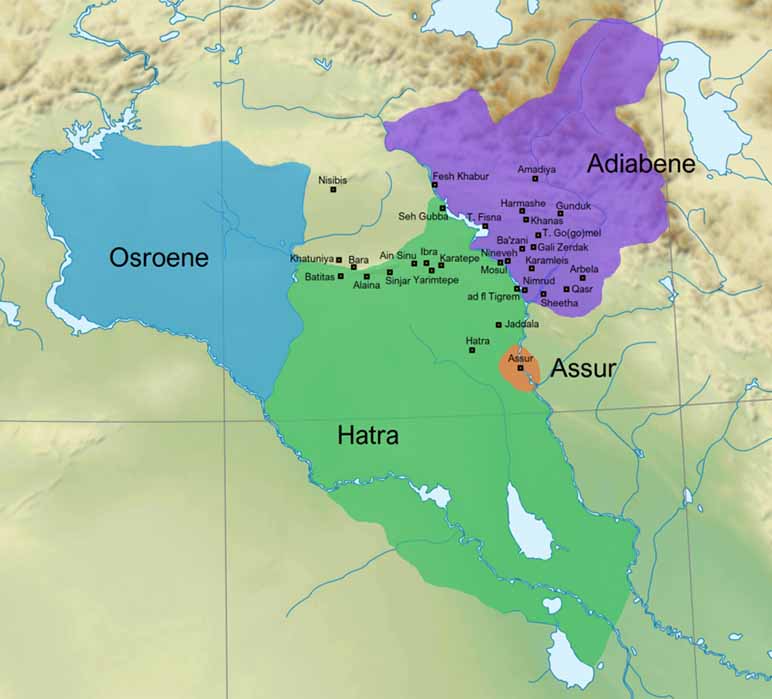
Hatra, Iraqi Sanctuary Of Deities Withstanding Assault Over 2,000 Years
The ruins of Hatra, located 290 kilometers (180 miles) northwest of modern Baghdad, tell the story of a second century AD Kingdom, whose rulers walked hand-in-hand with the reigning Arsacid Dynasty of the Parthian Empire. The origin of Hatra is shrouded in mystery, although the meaning of its name, ‘enclosure’ may indicate it was a place where nomadic Arab tribes congregated on neutral ground, around a religious centre. Mention is made of inscriptions referring to a powerful clan chieftain called Woron, who carried the title mry (lord) and his grandson Ma’n or Mannos and who were overlords over Singara on the Iraqi Nineveh plains and the deserted region east of Osroene.

Approximate map of the kingdom of Hatra (green) and other Parthian Mesopotamian vassal kingdoms (circa AD 200) (Ichthyovenator / CC BY-SA 4.0)
King Vologases III and Lord Nashrihab
During his reign between 78 to 110 AD, Pacorus II, son of the powerful King Vologases I, of the Arsacid Dynasty, ruled the Parthian Empire from their new capital Ctesiphon on the banks of the Tigris, and endeavoured to secure the regions around the caravan trade routes, which would have included Hatra, ruled over by lords. Vologases III (Greek form of the Parthian Walagasa) succeeded Pacorus II. A civil war ensued between Vologases III and Osroes I, who had seized the western part of the Parthian Empire, including Mesopotamia.
Emperor Trajan of Rome decided to take advantage of the civil war between the Parthian rulers to invade and expand Rome’s borders. In 116 AD Trajan burned Seleucia to the ground and captured Ctesiphon, the capital of the Parthians, where he installed Osroes I's son Parthamaspates - who was also his lover - on the throne at Ctesiphon. However, it was the fortified Hatra further north on the banks of the Tigris that withstood the Roman’s siege in 117 AD, despite the personal presence of Emperor Trajan on the battle field. Trajan died that same year. According to texts, either Elkud or his son mry’ Nashrihab were the most likely Lord of Hatra during the siege. Emperor Hadrian succeeded Trajan and spared Ctesiphon from destruction and Vologases III regained lost territory from Osroes I.

The ruins of the ancient city of Hatra, the city of the sun god, are located approximately 300 kilometers northwest of Baghdad, Iraq (Multi-National Corps Iraq Public Affairs/ Public Domain)
The lineage of Hatrene rulers succeeded from Elkud to Nashrihab, to his son Nasru (r. 128 – 140 AD). To reward the Hatrene rulers for withstanding the Romans, Vologases III granted Nasru and his successors the right to represent the Parthian Great King of Kings in Hatra, - they became vassals of the Parthian Empire - and Nasru’s sons were given Arsacid names to emphasize the close bond between Ctesiphon and Hatra. His oldest son Volgash / Wolgash reigned for a short while, after which he was succeeded by his brother Sanatruq I. It was probably during the reign of Sanatruq I that these Hatrene rulers took the title of malka (king) replacing the title of mry’ (lord).

Tetradrachm of Vologases IV, minted at Seleucia in 153. (Classical Numismatic Group/CC BY-SA 3.0)




